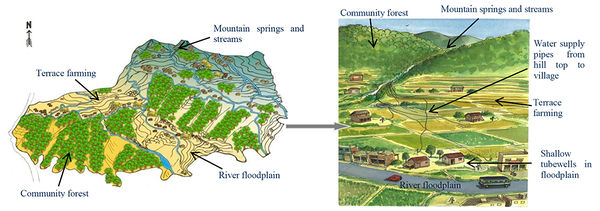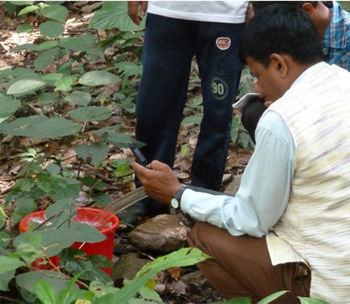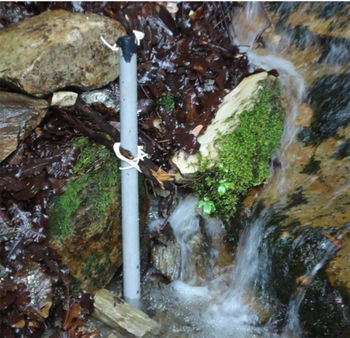OR/14/069 Field activities: Difference between revisions
m 1 revision imported |
|
(No difference)
| |
Latest revision as of 15:41, 8 March 2016
| Bricker, S H, Yadav, S K, MacDonald, A M, Satyal, Y, Dixit, A, and Bell, R. 2014. Groundwater resilience Nepal: preliminary findings from a case study in the Middle Hills. British Geological Survey Internal Report, OR/14/069. |
An intensive programme of fieldwork, comprising hydrological and hydro-chemical monitoring and catchment and community surveys was undertaken during the post-monsoon season (16th–26th September 2013) and pre-monsoon season (23rd April–7th May 2014) in order to characterise the hydrogeological setting of catchments in the Middle Hills and to evaluate water resources and water usage. In addition, longer-term hydrological monitoring and water usage surveys were undertaken in the interval between the two field visits (Sept–April 2014) with a limited amount of monitoring continuing post-April 2014. Full details of the work undertaken and the field investigations employed are outlined below. The locations of sampling sites and details of the samples collected and site monitoring are provided in Appendix 1 - Field data.
The results from the fieldwork should be viewed in the context of the antecedent weather conditions. In the absence of formal hydrometric data for our study catchments the following anecdotal antecedent weather conditions are provided. The first field visit in September 2013 was planned to capture the hydrological setting during the post-monsoon season. The monsoon season preceding the September field visit was described by locals in both Madanpokhara and Ramche/Nangi as being a particularly strong monsoon with more rain than normal. The second field visit in April and May was intended to capture the pre-monsoon hydrological regime, i.e. when groundwater resources are expected to be at their lowest. However residents in Ramche/Nangi noted that there had been rain and snowfall during the winter months of January and February, which was considered to be very unusual and more rain than normal had been received during the pre-monsoon months of March and April. Heavy afternoon rain showers were experienced on the first two days of field work in Nangi (25th and 26th April) however the rainfall did not result in discernible run-off due to large soil moisture deficits. Residents in Madanpokhara remarked that there had been no rain during the winter and pre-monsoon season prior to our visit and results are therefore expected to be reflective of a low groundwater resource situation.
Characterisation of groundwater resources and water usage
Water resources in the Middle Hills are under stress due to climate variability and changing land use practice such as deforestation, haphazard construction of roads and urbanization. Climatic variability and changes in precipitation, soil moisture and surface water, affects groundwater resources and spring flows and places increased stresses on local water management institutions. Other factors such as change in demand due to emerging aspiration for higher level of services, and deterioration of water quality will generate considerable stress on groundwater. As a result the temporal and spatial characteristics of groundwater are changing. The major issues in groundwater management in mid-hills of Nepal are considered to be:
- Loss of vegetation cover and forest
- Soil erosion and land degradation
- Land abandonment/encroachment and accelerated runoff
- Spatial and temporal variability in rainfall and availability of water — ‘too-little-and too- much water syndrome’
- Deteriorated water quality and health problems
- Glacier retreat and its impact on downstream rivers
- Non-availability of meteorological data
- Water induced hazards
- Dying wisdom of indigenous methods of coping up water scarcity and hazards
Assessment of impacts of environmental change on groundwater in Nepal’s Middle Hills has not received adequate attention. To overcome this limitation, two catchments in Nepal’s Middle Hills; Madanpokhara VDC and Ramche VDC as described in the Study area section are being monitored throughout a hydrological year to investigate the availability and use of groundwater.
Field observation: The visit to Madanpokhara and Ramche VDCs aimed to understand the status of water sources and uses. The local communities were consulted to identify the type of water sources and locate them using Global Positioning Systems (GPS). Information such as vegetation, land types (agricultural/barren land) and pollution status were also noted. Monthly water usage surveys were also undertaken January–March 2014 at four water supplies, two hand pumps in Madanpokhara and two spring sources in Ramche.
Focus Group Discussion: A detailed checklist was prepared and was used in the focus group discussion to solicit information related to past and present flow from sources, water supply management, disputes, scarcity issues and pollution. This interaction helped understand local perception of climate change and other water-related issues. The participants were the VDC secretary, school teachers, former chairperson of the VDC, and local farmers.
Observations: Madanpokhara: In Madanpokhara, villagers use stream and spring sources in different wards for drinking purpose. Among them, the highest number of sources is in ward six. Drinking water is supplied via concrete tanks and alcathene pipes in ward one and four (Figure 20). In the VDC, 16 water sources are reported to have dried up which the local community attribute to a change in rainfall patterns, mismanagement and landscape changes. For meeting drinking needs in ward one and four, water is lifted by pump from lower elevations. In ward six, seven and eight, the majority of the households use spring water from a gravity-fed piped water system and groundwater abstracted from shallow tubewells. CBS (2011)[1] indicates that 65% of households within the VDC use tap and piped water, 12% use tube well and rest use spouts. The water available for irrigation is not sufficient for cereal crops, especially for paddy and wheat so there is a heavy reliance on rainfall. For irrigation, four canals have been constructed — Khauruha canal in ward six and eight; Adherai Argaule canal in ward seven; Jaljale canal in ward seven and Budi Tinau canal in ward six. People of Madanpokara also use the Tinau River for irrigation, which originates from the Mahabharat range and flows through Mandi Phant and discharges to the Terai at Butwal.

In most settlements, households use ponds lined with plastic (ultraviolet proof) and ghaito (jars) to harvest and store rain. The water stored is used for irrigated vegetable farming. Rain is collected in open ponds, lined with plastic to be used in the dry season (March–May). The production of vegetables has benefited farmers and many community-based user groups are involved in distribution and other aspects of vegetable farming.
Ramche: In Ramche VDC, springs are used for drinking supplied through pipes to households (Figure 21). On average, about 70% of households in the VDC have access to piped water supply for drinking. The VDC has no irrigation system, primarily because there are fewer terraces. Though traditional irrigation canals cannot be built, drips and sprinklers can support off-season cultivation.

Dynamic groundwater system
Spring flow and temperature
As part of this study monitoring of spring flow was undertaken at 3 spring sources in Madan Pohkara (Baun Khola; Badkhola; Andheri Chharchare), 2 spring sources in Nangi (Rato Jhapra; Seto Kharsu) and 2 spring sources in Ramche (Thulo Mul; Citeni Mul). Flow was being measured by local members of the community using the bucket gauge technique, where the time taken for the spring to fill a bucket of known volume (8 litres) is recorded. Where the spring water is piped from the source, the spring flow was measured from the pipe. Where the spring is not piped directly for supply, spring flow was measured at a suitable point downstream where spring flow forms a discrete flow channel that can be collected by a bucket. With both techniques there is the possibility that small volumes of spring flow were not captured by the bucket. The spring flow measurements may therefore be an underestimate of the total spring flow, this is most likely to be the case during monsoon and post-monsoon season when spring flow is high and excess spring flow not used for water supply over-flows into adjacent streams at some sites. The temperature of the spring water was measured using a glass-mercury thermometer. Spring flow was measured twice a day (am and pm) at these sites from 2nd July 2013–15th Nov 2013 and weekly from the 15th Nov 2013 onwards. Arrangements have been made by ISET-Nepal to continue the monitoring of spring flow and temperature, by the local community members, on a weekly basis at these sites. In addition to the spring flow measurements, flow emanating from an artesian well (naturally over-flowing well) in the Madanpokhara catchment will also be monitored using a bucket gauge.

Stream levels
In addition to the spring flow measurements water levels within three streams which are fed by the springs and which flow alongside the springs have been monitored using an automatic data level recorder. Two of the sites are located in Nangi (Rato Jhapra and Seto kharsu) and one site is located in Ramche (Citeni Mul). Water levels in the streams were recorded by the data logger at a 15-min time interval. A temporary stilling well made out of perforated plastic pipe (~2 inch diameter) was installed into the stream bed at the side of the channel from which to hang the data logger and to protect it from strong currents and debris. The data loggers were installed in Sept 2013 and data from them downloaded in April 2014. The data loggers at Rato Jhapra, Nangi and Citeni Mul, Ramche were re-set in April 2014 for on-going monitoring. The data logger at Seto Kharsu, Nangi was removed in April 2014. The streams being monitored in Nangi and Ramche source some distance further upstream than the point at which they are being monitored. As such the stream levels being recorded will be representative of the hydrological regime higher up the catchment i.e. there may be additional springs, tributaries and snow melt contributing to the stream flow. Stream levels in Madanpokhara have not been monitored and no suitable shallow tubewells, unaffected by abstraction, were identified in the Madanpokhara catchment for long-term groundwater level monitoring. The stream level data are not presented within this report, further stream level data are being collected and will be subject to further processing and analysis.

Groundwater chemistry
Water samples for groundwater chemistry analysis (major and trace elements) were collected from 17 sites visited during the Sept–2013 field excursion and for 27 sites visited during the April/May–2014 field excursion. Groundwater chemistry samples were collected in order to assess the hydrogeological environment of the catchment rather than to assess the suitability of water resources for drinking water. However, concentrations of determinants in excess of the Nepal drinking water quality standards (DWQS) are highlighted where appropriate (Appendix 1 - Field data). Bacterial analysis of the water samples was not undertaken.
Where samples were collected from tubewells every effort was made to purge the well three times the well volume prior to collecting the sample or to collect a sample from a recently pumped well. Where this was not possible this was indicated in the field notes. At each site, measurements were made of alkalinity (by titration against H2SO4), temperature, specific electrical conductance (SEC), pH, dissolved oxygen (DO) and redox potential (Eh). The latter four parameters were measured in an anaerobic flow cell to prevent contact with the atmosphere and parameters were monitored until stable readings were obtained. In a few cases, use of a flow cell was not possible and on-site parameters were measured rapidly in a bucket. In each case a note was made of the sampling conditions.
Samples for major and trace element analysis were collected in factory-new rinsed polyethylene bottles and filtered to <0.45 μm. Filtration was performed using a disposable filter and syringe. Samples for cations and trace element analysis during the Sept–2013 field excursion were acidified at the end of each day to 1% (v/v) using HNO3 (nitric) acid. Since current aviation regulations prohibit the transportation of nitric acid on passenger aircraft nitric acid was locally-sourced from a Nepali chemist. However duplicate samples for cations and trace element analysis were collected and acidified to 1% (v/v) upon return to the UK in BGS laboratories using ARISTAR HNO3. Laboratory results from samples collected in Sept–2013 indicated that the HNO3 acid sourced in Nepal was contaminated with metals. Therefore samples collected during the April/May field excursion were acidified to 1% (v/v) upon return to the UK in BGS laboratories using ARISTAR HNO3. Samples for non-puregable organic carbon (NPOC) analysis were filtered through a 0.45 μm silver impregnated filter and collected in glass vials pre-cleaned with chromic acid.
Analysis of major and trace cations, and Iodine was carried out by inductively-coupled plasma mass spectrometry (ICP-MS). Anions were determined by ion chromatography (IC) and alkalinity testing of each sample repeated in the laboratory was determined by potentiometric titration. Samples for NPOC were analysed using a Total Organic Carbon (TOC) analyser.
Stable isotopes
The stable isotopes of water (δ18O and δ2H) can be used as a tracer of the origin of groundwater recharge since δ18O and δ2H ratios vary seasonally and with latitude, temperature and with altitude. Stable isotope samples were collected for the 17 sites visited during the Sept–2013 field excursion and for the 27 sites visited during the April/May–2014 field excursion. A rain sample was also collected for stable isotope testing during each field visit.
Three spring sources in Madanpokhara (Baun Khola, Badkhola and Andheri Chharchare), two springs sources in Ramche (Thulo Mul and Citeni Mul) and two spring sources in Nangi (Seto Jharsu and Rato Jhabra) have been selected for longer-term stable isotope sampling to access seasonal trends. Samples have been collected on a fortnightly basis from Oct 2013 to present. Due to the limited funds available for laboratory costs only monthly stable isotope samples for these seven springs, from Oct 2012–Mar 2013, have been submitted to the laboratory for testing.
Samples for the determination of stable isotopes (δ18O and δ2H) were collected unfiltered in factory-new rinsed polyethylene bottles.
Groundwater residence time indicators
Chlorofluorocarbons (CFC) and sulphur hexafluoride (SF6) are anthropogenic environmental tracers occurring in the near-surface environment. The concentration of CFC and SF6 in groundwater can be used to make inferences about the timescales of groundwater processes operating within the catchment. CFC and SF6 are particularly useful for dating groundwater less than 100 years old since concentrations of CFC and SF6 have been accumulating in the atmosphere since the late 1930s and early 1970s respectively and have a known groundwater solubility (Darling et al 2012[2]).
Samples for CFC and SF6 analysis were collected within a pre-rinsed glass bottle. It is essential that the sample is airtight and does not come into contact with the atmosphere. To achieve this, the water source is pumped (suction pipe or caravan pump) into the glass bottle which is placed within a bucket. The bucket is filled and overflows with the pumped water to completely submerge the glass bottle before the cap is secured to the bottle. The bottle cap is secured with electrical tape which is wrapped in a clockwise direction three times around the bottle neck.
Where samples were collected from tubewells every effort was made to purge the well of three times the well volume prior to collecting the sample or to collect a sample from a recently pumped well. Where this was not possible this was indicated in the field notes.
CFC and SF6 samples were collected from seven spring sources during the Sept–2013 field excursion and from 11 springs, one hot-spring, one large diameter well and eight tubewells during the April/May field excursion.
Noble gases
The temperature of groundwater recharge can be determined from the concentrations of Argon, Krypton, Neon and Xenon noble gases in groundwater and therefore provides an indication of the contribution of snow and ice melt to groundwater recharge and the recharge season and elevations.
Samples for noble gas analysis were collected from seven spring sources during the Sept–2013 field excursion and from three springs, one hot-spring and one tubewell during the Apr/May field excursion. The sample is collected in copper tubing. It is essential that the noble gas sample is airtight and does not come into contact with the atmosphere. To achieve this, the water source is pumped (suction pipe or caravan pump) and connected via a length of hose to the copper pipe which is then clamped shut. Where samples were collected from tubewells every effort was made to purge the well of three times the well volume prior to collecting the sample or to collect a sample from a recently pumped well. Where this was not possible this was indicated in the field notes. The noble gas sample results were not available at the time of reporting.